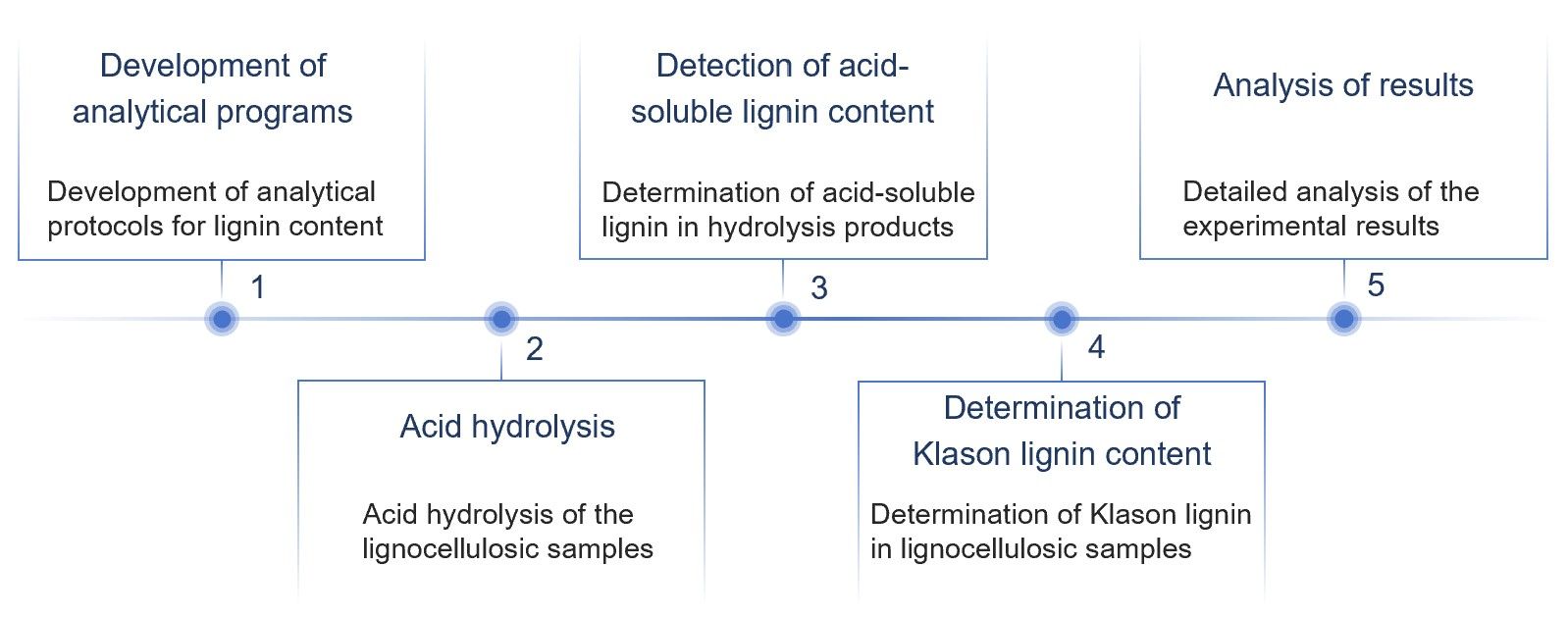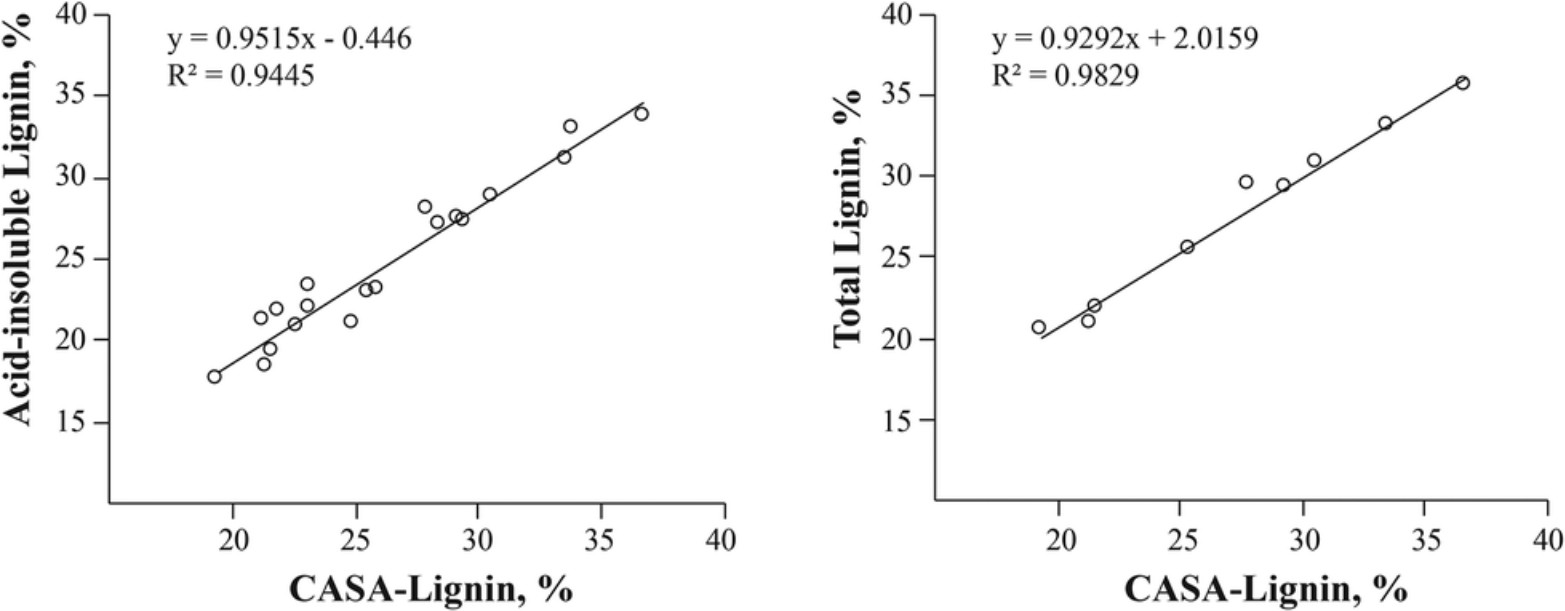Lignocellulose Lignin Profiling Service
Your Best Partner for Lignin Content Analysis
As a phenolic secondary metabolite, lignin content analysis is an important factor in evaluating the potential of biomass, such as lignocellulose, to be used as a feedstock for the production of bioenergy through processes such as biochemical or thermo-chemical conversion, etc. Creative Biolabs is continually refining and optimizing Lignocellulosic-related lignin content analyses to support our clients' research on a variety of lignocellulosic feedstocks. Our lignin content analysis methods are as efficient as Ash Content Analysis and Extractives Analysis.
The presence of lignin has a large impact on the industrial production of various lignocelluloses. We accurately and efficiently detect lignin content in various lignocelluloses, including Klason lignin and acid-soluble lignin content. The assay procedure may vary from sample to sample. The detection steps are as follows:
-
Acid hydrolysis of samples
Unless clients have special requirements, we carry out acid treatment for various lignocellulosic samples.
-
Detection of acid-soluble lignin content
Acid-soluble lignin is soluble in 72% sulfuric acid, and its content in lignocellulose is relatively small. We use ultraviolet and visible (UV-Vis) spectrophotometry to determine the content of acid-soluble lignin in the acid hydrolysis products.
-
Determination of Klason lignin content
Klason lignin is the insoluble residual fraction after the removal of ash by acid treatment. Its content is the difference between the acid-insoluble residue content and the acid-insoluble ash content.
Lignin content analysis provides valuable information on the composition and quality of Biomass such as lignocellulosic materials. Our researchers perform tests in strict accordance with standards to ensure the accuracy and precision of lignin content analysis results. Our goal is to support our clients in making the best use of lignocellulosic raw materials.
 Fig.1 Flowchart of lignin content analysis.
Fig.1 Flowchart of lignin content analysis.
Features of Lignin Content Analysis Service
-
Accurate results: We split all samples in two for testing to ensure accurate and precise experimental results.
-
Experienced analysts: We have rich experience in analyzing lignocellulosic samples from various pretreatment or other transformation processes.
-
Detailed lab reports: We have a complete procedure for analyzing lignin content and also provide the most detailed data after the experiment.
At Creative Biolabs, with many years of analytical experience, our lignin content analysis service is well established. We develop individualized plans and adjust them promptly according to the specific requirements of our clients. Please feel free to contact us for more detailed information about lignin content analysis.
Published data
Lignin is the second largest renewable raw material after cellulose. Measuring lignin content is important for lignocellulosic biomass process development and optimization. Traditional measurement methods have disadvantages such as lengthy processes. In this study, extensive research was carried out to find a new alternative method. Finally, a simple spectroscopic method, Cysteine-Assisted Sulfuric Acid (CASA) method, was successfully developed to quantify the lignin content in lignocellulose. To demonstrate the effectiveness of the method, the researchers used it to examine the lignin content in several plants. The results show that the method requires only a few milligrams of sample to produce accurate measurements. In addition to this, the reagents used in the method are easily available and the process is short, making it an efficient method. This study provides data and theoretical support for lignin content analysis.
 Fig.2 Correlations between the lignin contents.1, 2
Fig.2 Correlations between the lignin contents.1, 2
FAQs
Q1: Why is lignin content analysis necessary for lignocellulosic process development?
A1: Lignin is a complex compound in the cell wall. It inhibits cellulose hydrolyzing enzymes from breaking down cellulose, and even adsorbs and aggregates these enzymes, making the enzymatic process difficult. This greatly affects the efficient conversion of biomass such as lignocellulose. Therefore, the detection of lignin content is of great significance to how to effectively treat lignocellulose.
Q2: What are the common analytical methods for lignin?
A2: Understanding the chemical structure of lignin can be accomplished using a variety of techniques, including UV-Vis spectroscopy, Fourier transform Infrared (FTIR) spectroscopy, nuclear magnetic resonance spectroscopy, X-ray photoelectron spectroscopy, etc.
Customer Review
Flexible Analysis
"Although measuring lignin content was a routine operation for understanding lignocellulosic composition and developing lignocellulosic processes, it was still a challenging task for us. We always wanted to find a partner who would help us analyze lignin comprehensively. Since we partnered with Creative Biolabs, this problem was solved. They were able to adapt their protocols to our samples promptly, paving the way for research on our lignocellulosic processes."
Providing a Basis for Assessing Lignocellulose
"Understanding the lignin content of lignocellulose helps us to improve the utilization of our various feedstocks. That's why we turned to Creative Biolabs to address this critical aspect. They provide a high-quality lignin content analysis service. This provided us with an effective basis for evaluating the pretreatment methods for each raw material. Their dedicated analytical team was in close contact with us throughout the analysis process to ensure that our needs were best met."
References
-
Lu, Fachuang, et al. "A facile spectroscopic method for measuring lignin content in lignocellulosic biomass." Green Chemistry 23.14 (2021): 5106-5112.
-
Under Open Access license CC BY 3.0, without modification.
For Research Use Only.
Related Services

 Fig.1 Flowchart of lignin content analysis.
Fig.1 Flowchart of lignin content analysis.
 Fig.2 Correlations between the lignin contents.1, 2
Fig.2 Correlations between the lignin contents.1, 2

